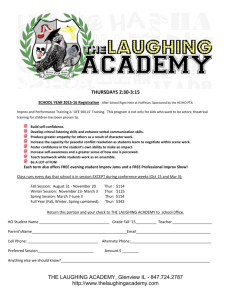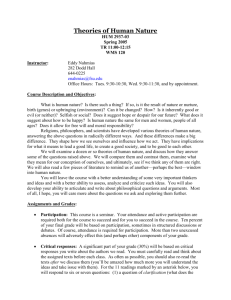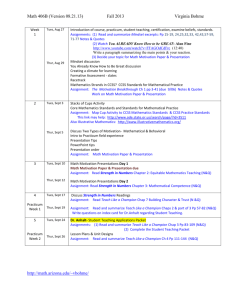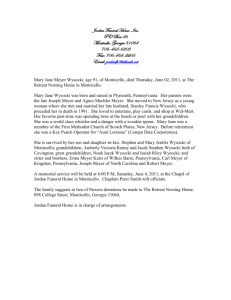METHODS OF EMPIRICAL INVESTIGATION
advertisement
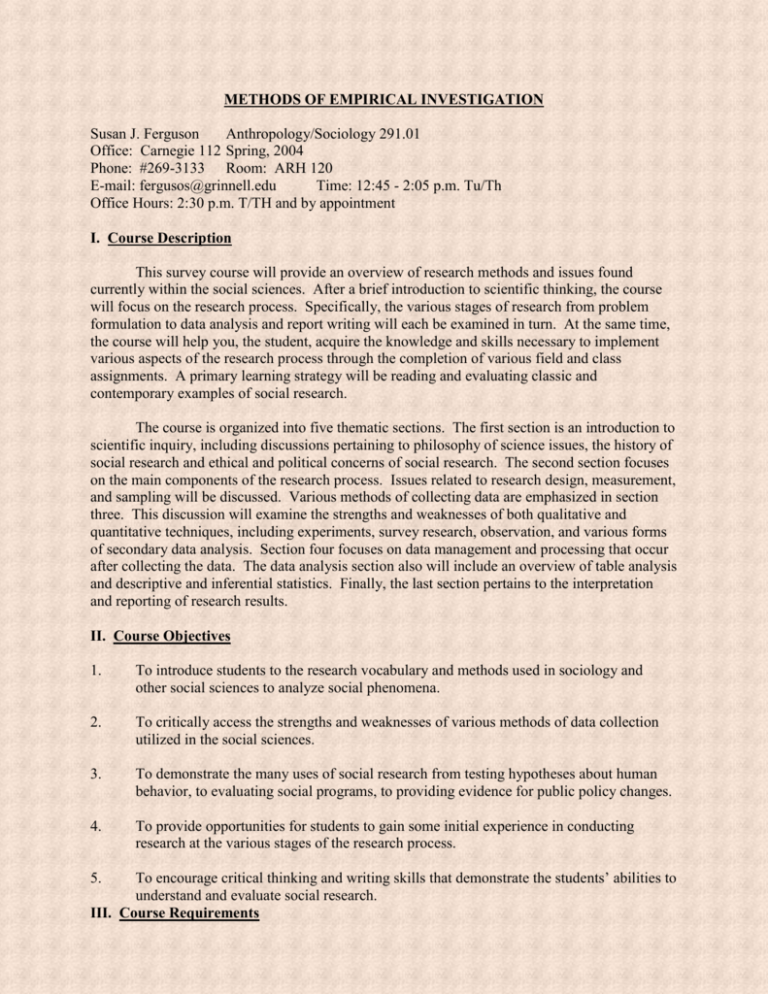
METHODS OF EMPIRICAL INVESTIGATION Susan J. Ferguson Anthropology/Sociology 291.01 Office: Carnegie 112 Spring, 2004 Phone: #269-3133 Room: ARH 120 E-mail: fergusos@grinnell.edu Time: 12:45 - 2:05 p.m. Tu/Th Office Hours: 2:30 p.m. T/TH and by appointment I. Course Description This survey course will provide an overview of research methods and issues found currently within the social sciences. After a brief introduction to scientific thinking, the course will focus on the research process. Specifically, the various stages of research from problem formulation to data analysis and report writing will each be examined in turn. At the same time, the course will help you, the student, acquire the knowledge and skills necessary to implement various aspects of the research process through the completion of various field and class assignments. A primary learning strategy will be reading and evaluating classic and contemporary examples of social research. The course is organized into five thematic sections. The first section is an introduction to scientific inquiry, including discussions pertaining to philosophy of science issues, the history of social research and ethical and political concerns of social research. The second section focuses on the main components of the research process. Issues related to research design, measurement, and sampling will be discussed. Various methods of collecting data are emphasized in section three. This discussion will examine the strengths and weaknesses of both qualitative and quantitative techniques, including experiments, survey research, observation, and various forms of secondary data analysis. Section four focuses on data management and processing that occur after collecting the data. The data analysis section also will include an overview of table analysis and descriptive and inferential statistics. Finally, the last section pertains to the interpretation and reporting of research results. II. Course Objectives 1. To introduce students to the research vocabulary and methods used in sociology and other social sciences to analyze social phenomena. 2. To critically access the strengths and weaknesses of various methods of data collection utilized in the social sciences. 3. To demonstrate the many uses of social research from testing hypotheses about human behavior, to evaluating social programs, to providing evidence for public policy changes. 4. To provide opportunities for students to gain some initial experience in conducting research at the various stages of the research process. To encourage critical thinking and writing skills that demonstrate the students’ abilities to understand and evaluate social research. III. Course Requirements 5. A. Exams: There will be two in-class exams (a mid-semester exam and a final exam) that will cover prior lecture and reading material. Any additional material provided by assignments, guest speakers, or videos also will be covered on the exams. The final exam is not comprehensive. Both exams are already scheduled in the course syllabus and students are expected to take the exams during the time period that is listed. There will be no makeup exams unless you have spoken with me prior to the exam and have a valid excuse. Each exam will count 20% of your final grade. B. Assignments: In addition to the two exams, there will be several required outside assignments. The purpose of these assignments is to determine how well you can utilize the research methods skills you are learning in class. The assignments will be relatively short in length and assigned fairly regularly. All assignments should be neatly written or typed and reflect thoughtful writing skills. Late assignments, if accepted, will be graded down. All assignments together will count for 20% of your final grade. C. Journal Article Analysis: Each student will locate a recent sociological article from a top sociology journal on a topic of their choice. Students will then read and evaluate the methods used in this research article. The goal of this assignment is to demonstrate your ability to understand and evaluate social research. You will be asked to summarize, critique, and evaluate the article based on what you have learned concerning research methods. Assignment instructions will be handed out later. Assignments should be typed and reflect thoughtful writing skills. This assignment will count for 10% of your final grade. D. Final Paper: Instead of a term paper, students will be asked to write a final paper that synthesizes the material learned during the semester. Specifically, this paper will take the form of a research proposal for a future research project that the student wants to conduct. The proposal can either be similar to a thesis proposal or to a research grant proposal. Thus, this proposal can either be an extension of the student's earlier research interests or a proposal focused on answering a question generated this semester in class. Note: A 1 2 page summary of your proposed research topic is due before spring break. This final paper should be about 6 to 8 pages in length plus appendices, and it will be due the last week of April. This paper will count for 20% of your final grade. E. Attendance and Participation: Since this course is required for sociology majors, students are expected to take an active role in shaping their learning environment both within and outside the classroom. This role includes regular attendance, leading and participating in class discussions, and group work. Attendance will be taken at the beginning of each class. Oral participation, class discussions, and attendance will count for 10% of your final grade. PLEASE NOTE: THERE WILL BE NO EXTRA CREDIT WORK. IV. Required Readings: The following books are available for purchase in the Grinnell College Bookstore. 1. Hoover, Kenneth and Todd Donovan. 2004. The Elements of Social Scientific Thinking. Eighth Edition. New York: St. Martin’s Press. 2. Katzer, Jeffrey, Kenneth H. Cook, and Wayne W. Crouch. 1998. Evaluating Information: A Guide to Users of Social Science Research. Fourth Edition. Boston, MA: McGraw-Hill. 3. Ragin, Charles C. 1994. Constructing Social Research: The Unity and Diversity of Method. Thousand Oaks, CA: Pine Forge Press. 4. Reinhartz, Shulamit. 1992. Feminist Methods in Social Research. New York: Oxford University Press. 5. Wysocki, Diane Kholos. 2004. Readings in Social Research Methods. Second Edition. Belmont, CA: Wadsworth Publishing. Supplemental Readings: In addition to using the readings listed above, I also will be supplementing the course reading list with several articles that help to address the diversity and complexity of research methodology. Plan on reading approximately three to five articles or chapters per class session. Please keep up with the syllabus by reading the assigned articles prior to the day that topic is discussed. Suggested Readings: Each week's description of readings also can be supplemented by reading chapters in standard social research methods texts in the library. I will place a few such texts on reserve for your information. These suggested readings are for those of you who want to read more or are especially interested in a particular topic. I also suggest looking at the reference lists and bibliographies at the end of each article and book for more sources. Questions to Think About While You Are Reading: Summary Questions: 1. What are the author’s primary research questions or hypotheses? 2. What is the author’s research design used to answer those questions and hypotheses? 3. What evidence does the author present in support of his or her arguments? Evaluation Questions: 4. What are the strengths and weaknesses of the author’s research design? 5. Do you agree with the author’s findings? Why or why not? 6. Do you have any problems with this study or how it was conducted? V. Course Outline With Reading Assignments SECTION ONE: INTRODUCTION TO SCIENTIFIC INQUIRY Tues. 1/20: Introduction to Course Thur. 1/22: Philosophy of Science Issues Read: Ragin, Chapter 1: “What is Social Research,” pp.5-30. Hoover and Donovan, Chapter 1: “Thinking Scientifically,” pp.3-13. Wysocki, Chapter 1: “Why Do You Need to Understand Research Methods,” pp.5-18. Garrity, Kimberly and Douglas Degelman. 1990. “Effect of Server Introduction on Restaurant Tipping.” Journal of Applied Social Psychology 20(2):168-172. Tues. 1/27: Goals of Social Research Read: Ragin, Chapter 2: “The Goals of Social Research,” pp.31-53. Katzer, et al., Chapter 1: “Purpose: What We Are Trying to Do,” pp.1-11. Katzer, et al., Chapter 2: “Research Assumptions: What We Believe About How We Know,” pp.12-22. Deaux, Kay and Randel Hanna. 1984. “Courtship in the Personals Column: The Influence of Gender and Sexual Orientation.” Sex Roles 11(5-6):363-375. Stidham, Ronald and Robert A. Carp. 1995. “Indian Rights and Law Before the Federal District Courts.” The Social Science Journal 32(1):87-100. Thur. 1/29: Ethical and Political Issues in Social Research Read: Wysocki, Chapter 3: “Ethics,” pp.53-77. Humphries, Laud. 1970. “Tearoom Trade: Impersonal Sex in Public Places.” Pp. 85-114 in The Research Experience, edited by M. Patricia Golden. Itasca, IL: F.E. Peacock Pub. Weitz, Rose. 1991. “Personal Reflections on Researching HIV Disease.” Pp. 187-198 in Life With AIDS. New Brunswick, NJ: Rutgers University Press. American Sociological Association. 1997. “Code of Ethics.” Washington, D.C.: ASA. Do: Exercise 1: Academic Resume SECTION TWO: THE COMPONENTS OF RESEARCH Tues. 2/3: The Research Process Read: Wysocki, Chapter 2: “Combining Theory with Research Questions,” pp.19-52. Ragin, Chapter 3: “The Process of Social Research,” pp.55-79. Hoover and Donovan, Chapter 2: “The Elements of Science,” pp.15-44. Romero, Mary. 1992. “Intersection of Biography and History: My Intellectual Journey.” Pp.1-16 in Maid in the USA. New York: Routledge Press. In Class: What makes good research problems? Thur. 2/5: Conceptualization Read: Hoover and Donovan, Chapter 3: “Strategies,” pp.47-67. Hoover and Donovan, Chapter 4: “Refinements,” pp.69-90. Wysocki, Chapter 5: “Conceptualization and Operationalization,” pp.101-131. Ransford, H. Edward. [1968]. “Isolation, Powerlessness, and Violence: A Study of Attitudes and Participation in the Watts Riot.” Pp. 292-314 in The Research Experience, edited by M. Patricia Golden. Itasca, IL: F.E. Peacock Publishers. Hertz, Rosanna and Susan M. Reverby. 1995. “Gentility, Gender, and Political Protest: The Barbara Bush Controversy at Wellesley College.” Gender and Society 9(5):594-611. Do: Exercise 2: Conceptualization Tues. 2/10: Measurement Read: Mutchnick and Berg, Chapter 2: “Issues of Measurement,” pp.29-39. Hoover and Donovan, Chapter 5: “Measuring Variables and Relationships,” pp.93-99. Katzer, et al., Chapter 9: “Measurement: How Does It Size Up?” pp.93-107. Kleg, Milton and Kaoru Yamamoto. 1998. “As the World Turns: Ethno-Racial Distances after 70 Years.” The Social Science Journal 35(2):183-190. Do: Exercise 3: Measurement Thur. 2/12: Sampling Read: Wysocki, Chapter 7: “Sampling,” pp.155-172. Hoover and Donovan, Chapter 5: “Measuring Variables and Relationships,” pp.100-109. Jackson, Pamela Braboy, Peggy A. Thoits, and Howard F. Taylor. 1995. “Composition of the Workplace and Psychological Well-Being: The Effects of Tokenism on America’s Black Elite.” Social Forces 74(2):543-557. Do: Exercise 4: Sampling Tues. 2/17: Research Designs Note: First assignment on the Journal Article Analysis is due at beginning of class. Knop, Edward. 1967. “Suggestions to Aid the Student in Systematic Interpretation and Analysis of Empirical Sociological Journal Presentations.” The American Sociologist May:90-92. Read: Wysocki, Chapter 4: “Research Design,” pp.79-100. Ragin, Chapter 4: “Using Qualitative Methods to Study Commonalities,” pp.81-103. LaFree, Gary D. [1980]. “Official Reactions to Rape and the Social Control of Blacks.” Pp.337-345 in Empirical Approaches to Sociology: Classic and Contemporary Readings, edited by Gregg Lee Carter. New York: MacMillan Publishing Company. SECTION THREE: DATA COLLECTION Thur. 2/19: Experiments Read: Wysocki, Chapter 8: “Experimental and Survey Research,” pp.173-175 and pp.178-186. Reinhartz, Shulamit. 1992. “Feminist Experimental Research.” Pp.95-108 in Feminist Methods in Social Research. New York: Oxford University Press. Haney, Craig, W. Curtis Banks, and Phillip G. Zimbardo. “Interpersonal Dynamics in a Simulated Prison.” Pp.157-190 in The Research Experience, edited by M. Patricia Golden. Itasca, IL: F.E. Peacock Publishers. Garst, Jennifer and Galen V. Bodenhausen. 1997. “Advertising Effects on Men’s Gender Role Attitudes.” Sex Roles 36(9-10):551-572. Do: Exercise 5: Experimental Design Tues. 2/24: Surveys Read: Wysocki, Chapter 8: “Experimental and Survey Research,” pp.175-177 and pp.187-200. Reinhartz, Shulamit. 1992. “Feminist Survey Research and Other Statistical Research Formats.” Pp. 76-94 in Feminist Methods in Social Research. New York: Oxford University Press. Bulan, Heather Ferguson, Rebecca J. Erickson, and Amy S. Wharton. 1997. “Doing For Others on the Job: The Affective Requirements of Service Work, Gender, and Emotional Well-Being.” Social Problems 44(2):235-256. Do: Exercise 6: Survey Design Thur. 2/26: Questionnaire Design Read: Bailey, Kenneth D. 1987. “Questionnaire Construction.” Pp.105-146 in Methods of Social Research. Third Edition. New York: The Free Press. Wysocki, Chapter 6: “Indexes and Scales,” pp.133-153. **** Review Wysocki, Chapter 5: “Conceptualization and Operationalization,” Do: Exercise 7: Questionnaire Construction Tues. 3/2: Interviews Read: Thompson, Paul. 1988. “The Interview.” Pp.196-216 in Voices of the Past. London: Oxford University Press. Reinhartz, Shulamit. 1992. “Feminist Interview Research.” Pp.18-45 in Feminist Methods in Social Research. New York: Oxford University Press. Blee, Kathleen M. 1998. “White-Knuckle Research: Emotional Dynamics in Fieldwork with Racist Activists.” Qualitative Sociology 21(4):381-399. Dull, Diana and Candace West. 1991. “Accounting for Cosmetic Surgery: The Accomplishment of Gender.” Social Problems 38(1):54-70. Do: Exercise 8: Interviews Thur. 3/4: Observation Read: Wysocki, Chapter 9: “Field Research and Unobtrusive Measures,” pp.201-216. Katzer, et al., Chapter 3: “Observation: Seeing Is Not Believing,” pp.25-35. Bogdan, Robert. 1972. “Appendix.” Pp. 73-96 in Participant Observation in Organizational Settings. Syracuse, New York: Syracuse University Press. Voss, Laurie Scarborough. 1997. “Teasing, Disrupting, and Playing: Cross-Gender Interactions and Space Utilization among First and Third Graders.” Gender and Society 11(2):238-256. Wallace, Jennifer J. 1990. “‘But You Don’t Live Here, Man’: Negotiating Social Reality at the Rosebush Hotel.” Symbolic Interaction 13(2):241-255. Do: Exercise 9: Observation exercise of some social setting. Due after Spring Break. Tues. 3/9: Doing Fieldwork: Notes From the Field Read: Reinhartz, Shulamit. 1992. “Feminist Ethnography.” Pp. 46-75 in Feminist Methods in Social Research. New York: Oxford University Press. MacLeod, Jay. 1995. “Appendix on the Making of Ain’t No Makin’ It.” Pp.270-302 in Ain’t No Makin’ It: Aspirations and Attainment in a Low-Income Neighborhood. Boulder, CO: Westview Press. Pierce, Jennifer. 1995. “Articulating the Self in Field Research.” Pp.189-214 in Gender Trials: Emotional Lives in Contemporary Law Firms. Berkeley, CA: University of California Press. Thur. 3/11: Midsem Exam in class. No readings. Review for exam. SPRING BREAK 3/13 to 3/29 Tues. 3/30: Hurray!!!! Unobtrusive Research: Archival Analysis and Meta-Analysis Read: Reinhartz, Shulamit. 1992. “Feminist Content Analysis.” Pp.145-163 in Feminist Methods in Social Research. New York: Oxford University Press. Wysocki, Chapter 9: Martin article, pp.216-227; and “Thinking Through the Heart,” by Ann Goetting, pp.228-234. Young, Tasia and Mary B. Harris. 1996. “Most Admired Women and Men: Gallup, Good Housekeeping, and Gender.” Sex Roles 35(5-6):363-374. Feingold, Alan and Ronald Mazzella. 1998. “Gender Differences in Body Image Are Increasing.” Psychological Science 9(3):190-195. Do: Exercise 10: Content Analysis Thur. 4/1: Secondary Data Analysis Read: Wysocki, Chapter 10: “Existing Data and Evaluation Research,” pp.235-247. Skop, Emily H. 2001. “Race and Place in the Adaptation of Mariel Exiles.” International Migration Review 35(2):449-471. McDowall, David. 1991. “Firearm Availability and Homicide Rates in Detroit, 19511986.” Social Forces 69(4):1085-1101. SECTION FOUR: Tues. 4/6: DATA ANALYSIS Data Management Read: Mutchnick and Berg, Chapter 5: “Data Organization and Analysis,” pp.181-185. Davis, Theodore J., Jr. 1995. “The Occupational Mobility of Black Males Revisited: Does Race Matter?” The Social Science Journal 32(2):121-135. Thur. 4/8: Data Processing Read: Ragin, Chapter 5: “Using Comparative Methods to Study Diversity,” pp.105-130. Ragin, Chapter 6: “Using Quantitative Methods to Study Covariation,” pp.131-153. In Class: Date Maker Analysis Tues. 4/13: Time Series Analysis Read: Readings to be announced. Thur. 4/15: Table Analysis Read: Mutchnick and Berg, Chapter 1: “Table Reading,” pp. 2-5. Hirsch, Travis. 1994 [1969]. “Control Theory and Juvenile Delinquency.” Pp.301-319 in Empirical Approaches to Sociology: Classic and Contemporary Readings, edited by Gregg Lee Carter. New York: Macmillan Publishing Company. *Ballard, Mary E. and J. Rose Wiest. 1996. “Mortal Kombat (tm): The Effects of Violent Videogame Play on Males Hostility and Cardiovascular Responding.” Journal of Applied Social Psychology 26(8):717-730. Do: Exercise 11: Table Analysis Tues. 4/20: Descriptive Statistical Analysis Read: Hoover and Donovan, Chapter 5: “Measuring Variables and Relationships,” pp.109-119. Wysocki, Chapter 11: “An Introduction to Statistics,” pp.257-281. Katzer, et al., Chapter 10: “Description: Are the Results Summarized Fairly?” pp.108117. 1 Norton, Kevin I., Timothy S. Olds, Scott Olive, and Stephan Dank. 1996. “Ken and Barbie at Life Size.” Sex Roles 34(3-4):287-294. Lisak, David and Susan Roth. 1990. “Motives and Psychodynamics of Self-Reported, Unincarcerated Rapists.” American Journal of Orthopsychiatry 60(2):268-280. Thur. 4/22: Inferential Statistics Read: Hoover and Donovan, Chapter 5: “Measuring Variables and Relationships,” pp.120-136. Katzer, et al., Chapter 13: “Inference: Are the Results Real...Or Could They Have Been Caused By Noise?” pp.146-162. Tingey, Holly, Gary Kiger, and Pamela J. Riley. 1996. “Juggling Multiple Roles: Perceptions of Working Mothers.” The Social Science Journal 33(2):183-191. Ellinger, Ken, David E. Wright, III, and Michael W. Hirlinger. 1995. “Brains for the Bucks? School Revenue and Student Achievement in Oklahoma.” The Social Science Review 32(3):299-308. SECTION FIVE: INTERPRETING AND REPORTING RESULTS Tues. 4/27: Writing and Communicating Research Results Read: Wysocki, Chapter 12: “Writing and Reading and Research Paper,” pp.283-297. Katzer, et al., Chapter 4: “Communication: Writing Adds Other Problems,” pp. 36-45. Katzer, et al., Chapter 5: “Interpretation: ...And Then You Read,” pp. 46-51. John, Daphne and Beth Anne Shelton. 1997. “The Production of Gender Among Black and White Women and Men: The Case of Household Labor.” Sex Roles 36(3-4):171-193. Do: Exercise 12: Never Married Interview Data Thur. 4/29: Evaluating Research Reports Read: Katzer, et al., Chapter 11 and 12, pp.118-145. Katzer, et al., Chapter 14: “Generality: Do the Results Apply to You?” pp.165-176. Raphael, Jody and Deborah L. Shapiro. 2002. “Sisters Speak Out: The Lives and Needs 2 of Prostituted Women in Chicago.” A Research Study for the Center for Impact Research, Chicago, Illinois. Tues. 5/4: How Is Research Used? Read: Ragin, Afterword: “The Promise of Social Research,” pp.155-166. Hoover and Donovan, Chapter 6: “Reflections: Back to the Roots,” pp.139-160. Thur. 5/6: Last Class. Course Summation Finals Week: Final exam is as scheduled by the college: Friday, 5/14 at 2 p.m. Summer Break! Hurray!!! Acknowledgments: In drafting this syllabus, I received helpful suggestions from several colleagues and the ASA Teaching Resource Guide on Research Methods. I especially want to acknowledge the help of Margaret Duncombe at Colorado College and Emily Stier Adler at Rhode Island College. Research Design: *Tjosvold, Dean. 1995. “Effects of Power to Reward and Punish in Cooperative and Compe titive Contex ts.” The Journa l of Social Psycho logy 135(6): 723736. Sampling: 3 *McAninch, Decile B. and Richard Milich, Ginger B. Crumbo, and Miriam N. Funtowizc. 1996. “Children’s Perception of Gender-Role-Congruent and -Incongruent Behavior in Peers: Fisher-Price Meets Price Waterhouse.” Sex Roles 35(9-10):619-638. Interviews: *Neuman, Susan B., Tracy Hagedorn, Donna Celano, and Pauline Daly. 1995. “Toward a Collaborative Approach to Parent Involvement in Early Education: A Study of Teenage Mothers in an African American Community.” American Educational Research Journal 32(4):801-827.


